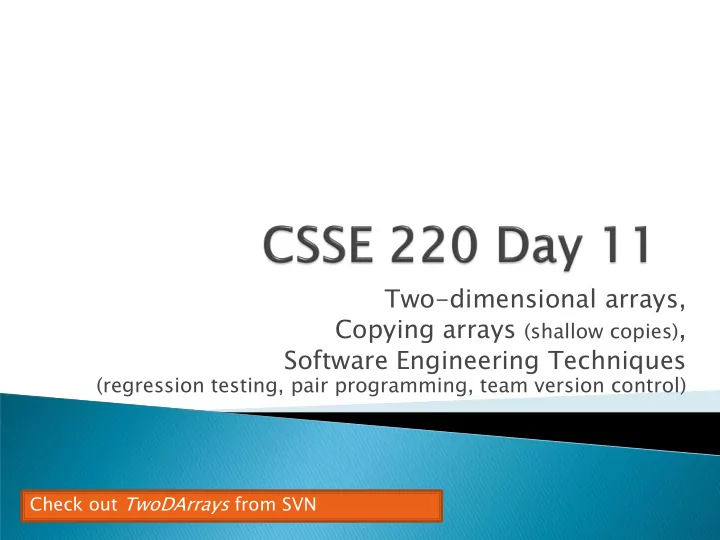

Two-dimensional arrays, Copying arrays (shallow copies) , Software Engineering Techniques (regression testing, pair programming, team version control) Check out TwoDArrays from SVN
public class TicTacToe { private final int rows; private final int columns; private String[][] board; /** * Constructs a 3x3 TicTacToe board with all squares blank. */ public TicTacToe() { this.rows = 3; What is the value of this.board[1][2] this.columns = 3; immediately after this statement executes? this.board = new String[this.rows][this.columns]; Could have used: this.board.length for (int r = 0; r < this.rows; r++) { for (int c = 0; c < this.columns; c++) { Could have used: this.board[r][c] = " "; this.board[r].length } Note the (very common) pattern: loop-through-rows, } Q2 for each row loop-through columns }
Complete the TODO items in TicTacToe and TicTacToeTest They’re numbered; do ‘ em in order. The Tasks tab lists the TODO’s. • The stub of the non-default constructor that we gave to you has a compile-time error; that is purposeful – you’ll correct that error as part of your TODO 1.
Assignment uses ref eferen erence values: ◦ double[] data = new double[4]; for (int i = 0; i < data.length; i++) { data[i] = i * i; data } 1 4 9 0 ◦ double[] pieces = data; pieces ◦ foo.someMethod(data); d This makes the field a dataInMethod reference to (NOT a copy of) a list that exists elsewhere in the code. public void someMethod(double[] d) { Think carefully about this.dataInMethod = d; whether you want this or ... a clone (copy). Q3-5 }
You can copy an array in any of several ways: 1. Write an explicit loop, copying the elements one by one 2. Use the clon one method that all arrays have Starting position in oldArray newArray = oldArray.clone(); Starting position in newArray 3. Use the System.ar em.array raycopy copy method: System.arraycopy(oldArray, 0, newArray, 0, oldArray.length); 4. Use the Arrays.c .copyOf pyOf method: Number of characters to copy newArray = Arrays.copyOf( oldArray, oldArray.length); The key point is that all of these except possibly the first make shallow copies – see next slide
Can copy whole arrays in several ways: ◦ double[] data = new double[4]; 1 4 9 0 ... data pieces = data; pieces ◦ double pizzas = data.clone(); 1 4 9 0 pizzas ◦ JLabel[] labels = new JLabel[4]; ... labels JLabel[] moreLabels = labels.clone(); hello ciao moreLabels Q6-8
http://xkcd.com/85/
Consider an ElectionSimulator: Instead of storing: ◦ ArrayList<String> stateNames; ArrayList<Integer> electoralVotes; ArrayList<Double> percentOfVotersWhoPlanToVoteForA ; ArrayList<Double> percentOfVotersWhoPlanToVoteForB ; We used: ◦ ArrayList<State> states; and put the 4 pieces of data inside a State object Why bother? We did (unwisely?) use parallel arrays in StateListTest: this.inputs = new ArrayList<String>(); this.correctResults = new ArrayList<String>(); Q9
Array or ArrayList, that is the question General rule: use ArrayList ◦ Less error-prone because it grows as needed ◦ More powerful because it has methods ◦ More general because it can be extended Exceptions: ◦ Lots of primitive data in time critical code ◦ Two (or more) dimensional arrays Q10
Regression testing Pair programming (next class) Team version control (next class)
Keep and run old test cases Create test cases for new bugs ◦ Like antibodies, the keep a bug from coming back Remember: ◦ You can right-click the project in Eclipse to run all the unit tests Q11-12
See the Schedule page, Session 12, for a link to a document that lists the topics covered by this exam Test Friday ◦ In class but you may have up to 50 mins of extra time. You can work from at 7:10-8:00 am or any of hours 1-4 that you are free. ◦ If you can’t do it in one contiguous chunk, you can only leave between the two parts of the exam – plan accordingly. Topics from Chapters 1-7 will include: ◦ A closed-book paper part: short answer, fill-in-the-blank, trace- code-by-hand, draw box-and-pointer diagrams, find-errors-in- code, write short chunks of code We have listed ALL the possible topics for this portion of the exam ◦ A programming part: 1-2 small programs, unit tests provided for some of them, you write unit tests for others Review in class Thursday ◦ Bring questions ◦ I won’t prepare anything but am happy to cover whatever you want, including working examples
There is nothing to turn in for Homework 12 ◦ It just points you toward resources you might find helpful in preparing for the exam (or in taking it!) ◦ You can email csse220-staff if you need help. There IS something to do for Homework 13 ◦ Reading and assessment on Angel over the reading ◦ Due at the beginning of Session 13 (Tuesday), as usual
Recommend
More recommend